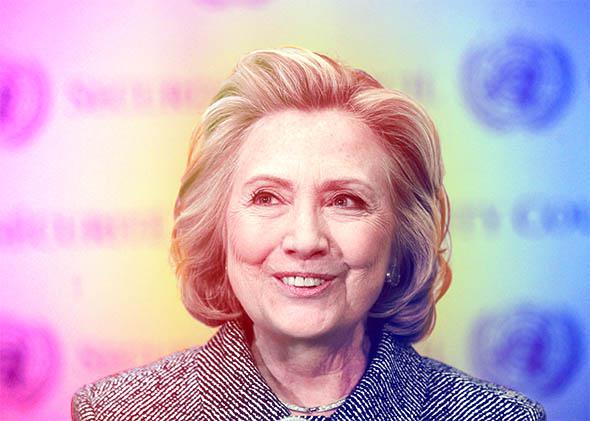Hillary Clinton has been polarizing her entire political career. But now, ahead of a second presidential run, she wants to be a uniter, not a divider. People should “get out of the kind of very unproductive discussion that we’ve had for too long, where people are just in their ideological bunkers, having arguments instead of trying to reach across those divides and have some solutions,” she said, speaking to labor leaders and policy wonks during a Monday event at the Center for American Progress, a liberal think tank that doubles as the Clinton administration-in-waiting.
Elsewhere in Washington, the Center on Budget and Policy Priorities—another left-leaning think tank—released its analysis of the new Republican budgets. “Each budget plan,” notes the CBPP, “derives more than two-thirds of its [approximately $5 trillion] budget cuts from programs for people with low or modest incomes even though these programs constitute less than one-quarter of federal program costs.” This includes billions in cuts to tax credits for working families as well as trillions in cuts to health care for low-income people. At the same time, House Republicans are mulling huge tax relief for the wealthiest Americans; later this week the House Ways and Means Committee will consider a bill to repeal the federal estate tax.
Clinton hasn’t announced a full agenda for 2016, much less a campaign for president. But when she does, it will stand on the opposite bank of anything offered by Republicans, with a vast distance between the two. She will give a plan for growing the welfare state. They will offer a plan for gutting it.
Put differently, she has to know that there’s no way to bring the two sides together. Democrats and Republicans aren’t just polarized; they’ve adopted distinct ideologies, and they’ve prioritized a maximalist approach to using power and influence. The first two years of the Obama administration weren’t modest. Part of this was a massive economic crisis that demanded a proportional response, but part of it was policy ambition. From the stimulus to the auto bailouts, Affordable Care Act, Dodd-Frank, and a host of other, smaller policies, Obama and the Democrats steered the country in a much more liberal direction than any president and Congress since Lyndon Johnson.
Likewise, if elected president in 2012, Mitt Romney had promised a full repudiation of the Obama administration. His White House would have slashed social spending, repealed the Affordable Care Act, and pushed a sweeping agenda of broad tax cuts and deregulation. It would have been a complete ideological victory, scored without any input from liberals.
It’s not that the “togetherness” talk is unreasonable. The public craves political comity and wants its leaders to affirm values like cooperation and bipartisanship. And even if they’ve built their appeal on the opposite, most politicians will oblige. “The answer will not come from Washington,” said Sen. Ted Cruz—of all people—in his presidential announcement speech. “It will only come as it has come at every other time of challenge in this country, when the American people stand together and say we will get back to the principles that have made this country great.”
But even if they try—and candidates tend to pursue their promises once in office—there’s no way anyone can keep this pledge. If elected president, Hillary Clinton won’t bring anyone together, just like Barack Obama didn’t overcome bitter partisanship and George W. Bush couldn’t sustain the national unity of his first two years in office (not that it was a huge priority). Not only are presidents pressured by party elites and activists with distinct visions, but the public is more polarized, and less willing to give approval or support to presidents from the other side. It’s why Clinton polarized more than Bush, why the second Bush polarized more than Clinton, and why Obama stands as the most polarizing president we have known—until we elect the next one.
Indeed, the only person in the present presidential field who seems to understand that political comity is a fool’s errand is Wisconsin Gov. Scott Walker, which, given his record for sowing ideological rancor, isn’t a surprise. In 2013—just after the government shutdown—he spoke at a breakfast for reporters in Washington, D.C. And when asked about polarization, he refused to say he could bridge the divide:
“For years, the conventional wisdom was that Americans want divided government,” he said. “I think they’ve seen in the last few years that that’s not necessarily a good thing. Instead of checks and balances you get a lot of gridlock.” …
“What we learned in Wisconsin and what many of the other battleground states, particularly in the Midwest, learned during the 2010 election, was that if you want to get big, bold reform done in your state you need a team to help you do that. So in our case everything switched from Democratic control to Republican control in 2010 and that empowered us to go out and make reforms that would’ve been much more difficult without those changes.”
It’s clear that Clinton wants to echo Barack Obama’s 2008 campaign of change and togetherness. But, as per her critique in the 2008 Democratic primaries, Obama’s message was a mistake. Outside of the most technical or non-salient issues, there’s no chance of bipartisan cooperation in the next presidential administration, and to promise otherwise is to set yourself up for failure. The only way a President Hillary Clinton will succeed in 2017 is if she has a Democratic Congress to pass her policies, confirm her judges, and staff her administration.
In other words, Clinton needs to listen to Walker. He gets it. Instead of a promise to work with Republicans, Clinton should promise to elect Democrats. It’s the only way she’ll get results, and ultimately, that’s what the public wants.
